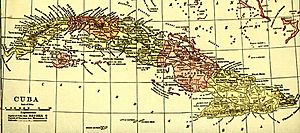Oriente Province facts for kids
Quick facts for kids
Province of Oriente
Provincia de Oriente
|
||
|---|---|---|

the Maisí lighthouse in the extreme eastern end of Cuba
|
||
|
||
| Seat | Santiago de Cuba | |
| Population
(2015)
|
||
| • Metropolitan region | 3,965,783 | |
| • Urban | 2,616,226 | |
| • Rural | 1,349,557 | |
| Demonym(s) | orientales | |
Oriente (which means "East" in Spanish) was the easternmost province in Cuba until 1976. Even today, people still use the name "Oriente" to talk about the eastern part of the country. This area is now split into five different provinces. Famous Cuban leaders Fidel and Raúl Castro were born in a small town called Birán in this region.
The idea of Oriente started in 1607 when Cuba was divided into two main areas: a western and an eastern part. The eastern part was managed from Santiago de Cuba. It reported to the main government in Havana. In 1807, Cuba was split into three "departments": Occidental (West), Central, and Oriental (East). This setup changed in 1851 when the central department joined the West again.
In 1878, Cuba was divided into six provinces. Oriente stayed mostly the same. It was officially renamed Santiago de Cuba Province for a while. But in 1905, its name went back to Oriente. This lasted until 1976. That year, the large Oriente province was split into five smaller ones. These new provinces are Las Tunas Province, Granma Province, Holguín Province, Santiago de Cuba Province, and Guantánamo Province. This change was made official by a Cuban law on July 3, 1976. These five provinces remain in place today.
Contents
History of Oriente Province
The city of Santiago de Cuba was founded in 1514 by Diego Velázquez de Cuéllar. It became the capital of Oriente province. This province was Cuba's largest, covering about 14,641 square miles (37,970 square kilometers). It was home to about one-third of Cuba's population. Oriente Province is in the far eastern part of Cuba. It has many mountain ranges, including the Sierra Maestra. This range has Cuba's highest mountain peak, Pico Turquino.
Oriente Province is very important in Cuba's history. Besides being the birthplace of Fidel and Raúl Castro, many historical events happened here. José Martí, a Cuban national hero, was killed in battle at Dos Ríos in this region. Many guerrilla wars also took place in Oriente. Cuba's first guerrilla-style war happened in 1523. It was fought against the Spanish in the Sierra Maestra Mountains. Some of Cuba's oldest cities, like Baracoa, are in Oriente Province. They hold a rich history of Cuba's fight for independence and fairness.
Struggles for Freedom and Equality
During the 1800s, many enslaved African people were brought to Cuba. They were forced to work on sugar farms. Some enslaved people also came from Haiti and other nearby islands. They were seen as cheap labor. A major independence movement led to open warfare from 1867 to 1878. Slavery was finally ended in 1886. However, life remained difficult for many Afro-Cubans, especially in Oriente Province.
After the Spanish left Cuba in 1899, Oriente Province became a safe place for Afro-Cubans. Oriente had the most individual land owners and renters. About 96% of the people living there were born in Cuba. Afro-Cubans made up about 26% of the farm workers. Of all the land owned by Afro-Cubans in Cuba, 75% was in Oriente Province. Even though Afro-Cubans had better chances in Oriente, poverty was still widespread. They faced unfair treatment from wealthy Cubans and foreign land owners.
Economic Challenges and Protests
Sugar and coffee were the main crops grown in Oriente. At its peak, there were 41 sugar mills across the region. Foreign investors saw a chance to make money. They started buying a lot of land to grow more sugar. As investors bought land, local farmers were pushed out. This caused a lot of anger. Poverty grew, and by May 1912, Cubans in Oriente Province were very frustrated.
Large protests broke out. Afro-Cubans began to take goods and burn businesses and property owned by foreign investors. In response, the Cuban government sent the army. They burned the property of Afro-Cubans and killed many people. Within two years, half of the sugar mills in Oriente were owned by U.S. investors. Life became almost unbearable for Cubans working in the province. The arrival of Americans, Jamaicans, Bahamians, and Haitians, brought in by the United Fruit Company, made racial problems worse. These problems had not been as bad before the U.S. took control in 1898. Cuba's national hero, José Martí, had called for a country where all races were treated equally.
Modern Day Provinces
The area that was once Oriente Province is now divided into five different provinces. Each has its own municipalities (smaller local government areas).
Granma Province
Guantánamo Province
Holguín Province
Las Tunas Province
Santiago de Cuba Province
See also
 In Spanish: Provincia de Oriente (Cuba) para niños
In Spanish: Provincia de Oriente (Cuba) para niños
- Timeline of Santiago de Cuba (city)
Images for kids





